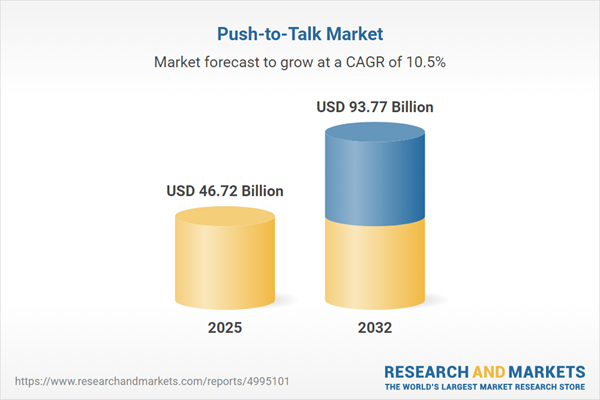Speak directly to the analyst to clarify any post sales queries you may have.
Push-to-talk technology is transforming organizational communications by providing instant, reliable voice connectivity for enterprises undergoing digital transformation. As businesses adapt to new working models and operational pressures, push-to-talk solutions empower leaders to enhance situational awareness, coordinate distributed teams, and protect workforce safety in demanding environments.
Market Snapshot: Push-to-Talk Market Trajectory
The global push-to-talk market is set for substantial expansion, with projections that it will increase from USD 42.33 billion in 2024 to USD 93.77 billion by 2032, driven by a compound annual growth rate of 10.45%. This growth reflects increasing demand for rapid, dependable communication tools across public safety, transportation, utilities, and governmental sectors. Companies are seeking agile communication solutions not only to guide real-time decision-making but also to optimize collaboration and streamline operations, especially in distributed or mission-critical environments. Businesses are integrating push-to-talk platforms with voice, data, and workflow management tools to advance operational resilience and support evolving business processes around the globe.
Scope & Segmentation of the Push-to-Talk Market
This report empowers executives to navigate the push-to-talk ecosystem by clarifying its primary segments and their strategic impact:
- Device Types: Dedicated radios, multi-platform smartphones, rugged tablets, and industry-focused wearables allow businesses to match device selection with unique operational demands and settings, from outdoor to high-risk environments.
- Service Models: Public cloud, private cloud, and on-premise deployments support regulatory adherence, security, and integration needs, facilitating tailored implementation across diverse sectors and geographies.
- End User Verticals: Commercial enterprises, emergency services, logistics, and the energy sector are adopting push-to-talk to reinforce secure, fast communication and agile response in critical scenarios.
- Applications: Voice-centric and data-forward platforms, workflow integration, and enterprise-grade tools enable collaborative work and business continuity during dynamic or emergency situations.
- Regional Coverage: Analysis spans the Americas, Europe, Middle East, Africa, and Asia-Pacific, considering localized adoption trends, regulatory contexts, and competitive dynamics that drive market penetration and innovation.
- Leading Companies: The market’s evolution is shaped by Motorola Solutions, Hytera Communications, JVC Kenwood, Thales Group, Airbus SE, Ericsson, Nokia, Cisco Systems, Sonim Technologies, and Zebra Technologies, all advancing technology adoption and product performance.
Key Strategic Takeaways for Decision-Makers
- Push-to-talk solutions foster immediate communication and task allocation, supporting both frontline response scenarios and office-based collaboration.
- Flexible deployment options—including private cloud and on-premise—help organizations keep pace with industry-specific regulations and evolving compliance requirements, ensuring operational continuity.
- Interoperable solutions enable multinational companies to maintain consistent processes and facilitate knowledge exchange, regardless of location or organizational scale.
- Integrating rugged and wearable devices minimizes downtime due to adverse conditions, supporting resilient communication in remote, hazardous, or fast-changing settings.
- Standardized application programming interfaces (APIs) and scalable integrations equip IT decision-makers to future-proof communication infrastructure as their footprint expands across new regions.
- Purpose-built workflow tools enhance team effectiveness amid geographic dispersion and shifting business conditions, enabling sustained performance and agility.
Tariff Impact on Push-to-Talk Supply Chains
Recent tariff changes in the United States are prompting manufacturers to reevaluate sourcing for radio modules and chipsets. In response, organizations are expanding supplier bases and prioritizing regional production to safeguard operational and supply flexibility. Additionally, there is greater emphasis on software-driven, subscription-based services, providing organizations with the adaptability and cost control needed for rapidly changing operational requirements.
Methodology & Data Sources
This market research draws on direct interviews with industry leaders and end users, augmented by comprehensive secondary research. Patterns are confirmed through analytical modeling and peer reviews, strengthening the report’s relevance and accuracy for enterprise communication decision-makers.
Why This Report Matters for Senior Decision-Makers
- Gain actionable insights into emerging push-to-talk trends, compliance shifts, and strategies for mitigating enterprise risks and optimizing capital investments.
- Evaluate supplier capabilities and design scalable, robust communication platforms that support both local market requirements and international growth ambitions.
- Access proven approaches to bolstering supply chain resilience and sustaining business operations in fluid geopolitical and commercial landscapes.
Conclusion
By leveraging these market insights, executive teams are positioned to accelerate technology adoption, reinforce business resilience, and secure reliable communication throughout organizational evolution and expansion.
Additional Product Information:
- Purchase of this report includes 1 year online access with quarterly updates.
- This report can be updated on request. Please contact our Customer Experience team using the Ask a Question widget on our website.
Table of Contents
3. Executive Summary
4. Market Overview
7. Cumulative Impact of Artificial Intelligence 2025
Companies Mentioned
The companies profiled in this Push-to-Talk market report include:- Motorola Solutions, Inc.
- Hytera Communications Corporation Limited
- JVC Kenwood Corporation
- Thales Group
- Airbus SE
- Telefonaktiebolaget LM Ericsson
- Nokia Corporation
- Cisco Systems, Inc.
- Sonim Technologies, Inc.
- Zebra Technologies Corporation
Table Information
| Report Attribute | Details |
|---|---|
| No. of Pages | 198 |
| Published | October 2025 |
| Forecast Period | 2025 - 2032 |
| Estimated Market Value ( USD | $ 46.72 Billion |
| Forecasted Market Value ( USD | $ 93.77 Billion |
| Compound Annual Growth Rate | 10.4% |
| Regions Covered | Global |
| No. of Companies Mentioned | 11 |









